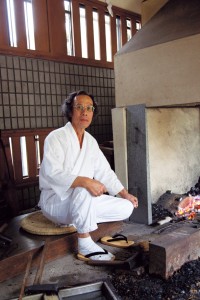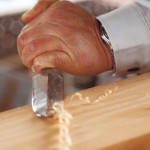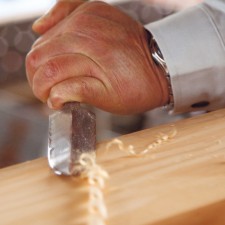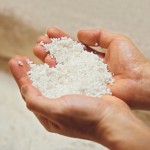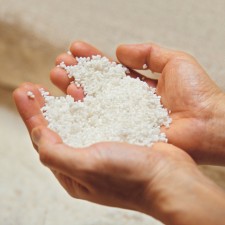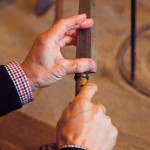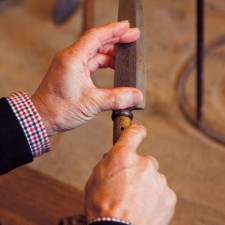Going beyond swords that “do not break, do not bend, and cut well”
The Gassan smithing tradition
The Bizen art of making swords is known as the Bizen style, and there is also a Yamato style and a Soshu style. Among these, the swordsmith Masamune, who perfected the Soshu style in the late Kamakura period (early 14th century), established a peak in sword-making technology. The Kamakura and Muromachi periods was a time when the swordsmiths consciously competed with each other. There were excellent swordsmiths in the Edo period too, of course, like Sukehiro or Kotetsu, who certainly didn’t lag behind Masamune.
Even today many swordsmiths strive for the heights of Masamune and other legendary masters. Steel changes over the years, its charm and its flavor may increase, but a blade isn’t necessarily good just because it’s old. Every age has its masters. However, their greatness may be hard to recognize until you’ve seen a fair number of swords. A bad sword feels lacking in dignity at first glance. Concretely speaking, the curving or the shape might be bad or the tempering dissatisfying, but these are all things that only a trained eye will notice.
The Gassan school derives, as its name suggests, from Mt. Gassan in the old province of Dewa (present-day Yamagata prefecture), and is characterized by a wavy grain called ayasugi hada. According to tradition, it was founded by a smith named Kiomaru (or Kishin Dayu, as he was also known), who lived in the sacred grounds of Mt. Gassan back in the 12th century. Ever since, swordsmiths have flourished at the foot of Mt. Gassan, and a number of masters have appeared, in a long succession. From the Kamakura period through the Muromachi period, swords inscribed with the Gassan signature were famous all over the country for their practical usefulness and the beauty of their ayasugi hada, but when the Warring States period ended at the end of the 16th century, the number of blacksmiths dwindled. From the start, Mt. Gassan was a site of mountain worship, and the blacksmiths who lived there were peculiar people who secluded themselves among the mountains to purify themselves before forging swords. They were ascetics, similar to Shugendo practitioners. Gassan was the name of the object of worship, and inscribing such a name on a sword would normally be inexcusable. Probably Gassan swords were originally intended for funeral rites, rather than as weapons. They were not meant for killing people, but were associated with the faith, I believe. The Gassan school’s ayasugi hada layer appeared when steel with different carbon contents were mixed and combined at a certain point, but the formula was kept secret.
At the end of the Edo period, Gassan Sadayoshi, who was the successor to the Gassan smiths, moved to Osaka. I believe he wanted to show the world the Gassan spirit one more time. My great-grandfather, the first Gassan Sadakazu, was a smith of awesome skill. If he had been active in the Kamakura period, I’m sure he would have ranked as an equal with Masamune. Not only did he master the Gassan style, he also made swords in the Bizen, Soshu, Yamato, Yamashiro and Mino styles, and all of them were top class. He even did sword engravings. There is nobody like him. The appreciation of his swords will only increase over the centuries.
It was during the time of my father, the second Sadakazu, that the smithy moved from Osaka here to Miwa. Maybe back in ancient times ascetics with Gassan swords in their belts wandered down to Yamato, climbed Mt. Omine and arrived here in Miwa. There is actually a place called Gassan Valley halfway up Mt. Miwa.
Forging a sword with heart and soul
Making a Japanese sword is a complicated process that takes almost a year. It is also very difficult to complete successfully, and like pottery, far from every piece gets finished. You beat out three or four swords, and one of them is tempered and turned into a finished product for the time being. If a crack appears, you stop right there. The process starts from tamahagane, a steel material which is made in a traditional tatara furnace. This manufacturing method has been revived in Okuizumo in Shimane prefecture especially for swordsmiths. Tamahagane is made by smelting iron sand, which is an extremely laborious task that takes three days and three nights of work around the clock.
The summer season is dedicated to finishing and engraving the swords. During the polishing, first the shape, width and measurements are determined, and then the blade is sharpened and finished. The work of the scabbard-maker and the polisher requires another two or three months.
The forging is an essential part of the sword-making procedure. The master is surrounded by three disciples who beat the iron. With experience, the disciples learn to read their master’s mind, but it is difficult to remain in harmony. You have to hit the right spot at exactly the right timing. Striking precisely in the middle is also difficult. As the disciples get more experienced, they learn to utilize the reaction to beat in a rhythmical way.
The master judges whether the steel is properly tightened or soft by the feel in his hands, the color and the condition of the iron at each moment. Sometimes water is poured onto the red hot steel which is then pounded to remove impurities in the form of iron oxides on the surface through steam explosions. This is done to prevent contaminants from entering the steel when folding it. During the forging, the steel is folded any number of times using a chisel to create multiple layers. If you fold it 15 times, for example, you get over 30.000 layers. This generates an adhesiveness that makes the blade hard to bend or break.
Japanese swords have to meet both the contrary requirements of hardness and durability. This is achieved by wrapping the soft, low-carbon shingane (core steel) in firmly forged kawagane (surface steel) with a comparatively high carbon content. Furthermore, when splashing water on the red workpiece, you can judge the ingredients of the iron by how the water droplets are repelled. When the forging is sufficient, the shingane is wrapped into the kawagane, and the piece stretched out. If it is twisted even a tiny bit, it is ruined. I then continue to work alone for a day or two, while adjusting the dimensions.
Tempering reflects your state of mind
One step where you really have to brace yourself is the tempering process. It will reflect your state of mind at each moment, so you have to prepare yourself from when you wake up. Early in the morning while it is still quiet I enter the smithy with two of my assistants. I keep the room dark so that we can see the color of the sword and the flames. The whole sword from base to tip is then heated to an even temperature. If you let your concentration slip even for an instant, some parts will be cooler than the others, so you must be very careful. During both forging and tempering, we adjust the color of the flames with bellows. They mustn’t get too red. You have to judge the best level. The hues of the sword and the flames are very hard to explain in words. It is something you can only learn by experience.
The temperature of the quenching water is also something you have to decide by experience. Iron ores are all different, so there is no fixed rule. It’s more like “For this iron, the water should be a bit lukewarm.” But it is a really important point, as this is where the shape of the curving is determined. There is even an anecdote about a disciple of Masamune’s who tried to steal the secret of the water temperature by putting his hand in it and had his arm sliced off. I use old water that I have drawn and left to stand to let all superfluous gas evaporate.
During the tempering the surface is covered with clay. As the sword curves back in the water, the clay cracks and comes off, and you can tell if the process is going well by how the clay is cracking. Clay is fire-resistant and doesn’t come off the steel easily. Different swordsmiths use clay from different regions, but I follow the family tradition and use clay from Osaka.
No matter how skilled you are at tempering, if the blade isn’t properly forged to begin with it won’t react to the tempering. Even if you increase the temperature of the blunt steel, the tempering won’t work the way you want. It sometimes happens that the blade comes out dull and lackluster, second-rate. The work of a swordsmith involves various complicated processes, but when the tempering reaches a certain point successfully I always draw a sigh of relief.
Forging and tempering are the most important steps, but even after handing over the sword to the polisher, you can’t really relax until everything is finished.
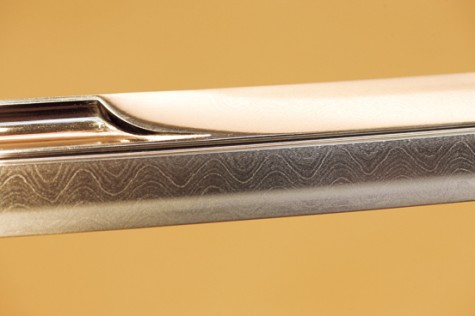
The wavy ayasugi hada grain is a major characteristic of the Gassan school.
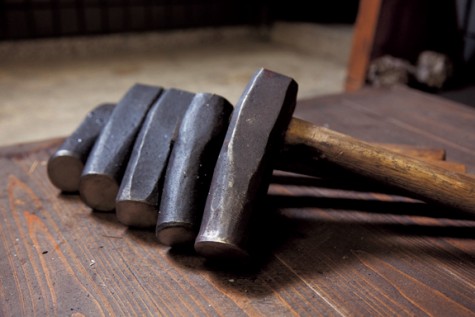
Small hammers.
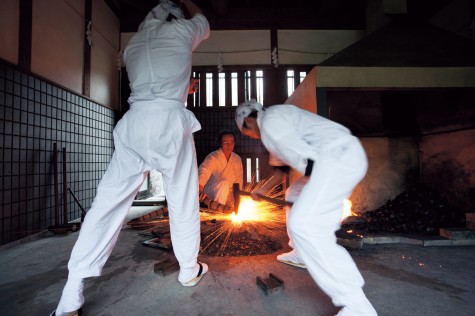
Sadatoshi Gassan forging. Judging by the color of the sparks and the workpiece, as well as the vibrations transmitted to his hands, he determines the carbon balance of the steel. Considerable skill is demanded of the hammer-wielders too.
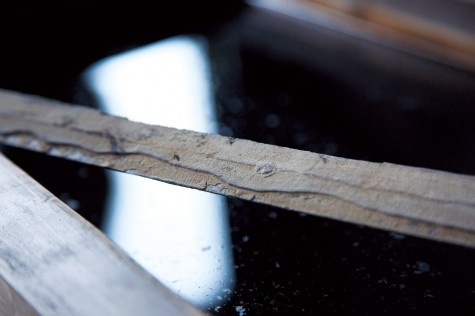
During the tempering, the blade is covered with clay to increase the cooling rate. Afterwards, the result of the tempering is inferred from how the clay has cracked.
Things I’ve learnt from my predecessors
Keeping the workplace clean is a cardinal rule. It was something my father, who was also my teacher, insisted on: always keep clean. The smithy is a sacred place, and cleanliness also helps prevent accidents. Furthermore, a swordsmith is always facing the flames. This is not a job you can do if you are afraid of getting burnt. When I was young and realized how profound it was, I sometimes thought I had chosen a forbidding line of work.
The essence of a Japanese sword is not a question of how well it cuts. If it is polished the right way, it will be very sharp, and if a master of iaido swings it, it will definitely cut. What we are aiming for is something beyond that. Also,, the regulations of the Japanese Agency for Cultural Affairs don’t allow us to release unsigned blades on the market. Swords that I engrave with my name will last for hundreds of years, so naturally I feel a corresponding responsibility for my work. My teacher (my father) released very few of his works after he became a living national treasure. His sense of responsibility was so strong that he didn’t want to present anything he wasn’t completely satisfied with himself.
He was a man of few words, so I learnt by watching him at work. Silent coaching, it was. My great-grandfather, the first Sadakazu, was a famous swordsmith who worked for the imperial family, but he too left behind a note saying that being a swordsmith is a lifetime of practice.
Succession and the appeal of Japanese swords
At the time of the Meiji Restoration, a decree was promulgated banning the bearing of swords, and the occupation forces after World War II even prohibited manufacturing swords. The modern period has been harsh for us, but recently young swordsmiths are appearing all over the country. Apparently they see a famous sword at a museum or someplace when they are in high school, and get the idea to try to make one themselves. The greatness of Japanese swords is quite hard to appreciate, but most of the young people who come to us are attracted by the unique ayasugi hada of the Gassan school. Swordsmiths don’t have to worry about finding successors for now. The problem is rather with finding successors to the charcoal-makers. To make one blade requires ten 12-kilo sacks of charcoal. We use a special pine charcoal from Iwate prefecture. Good charcoal makers are indispensable to keep the Japanese sword tradition alive.
In order to train as a swordsmith you need approval from the Agency of Cultural Affairs and you can count on about five years of training. To become independent takes about eight years, and to start meeting orders about ten. Actually it is afterwards that it gets really hard. In the old days, the apprentices started as children doing miscellaneous chores, so it took even longer to become independent.
Compared to other arts and crafts like pottery or lacquerware, swords are something you rarely come across in daily life, but many people are fascinated when they see a real sword for the first time. Recently, orders from abroad are increasing, and swords have become a symbol of Japanese spiritual culture. It is rather the Japanese themselves who seem to have forgotten the appeal of Japanese swords.
Swords in other countries are fundamentally different. Take polishing, for example. Only Japanese swords go through so many processes to achieve that special sheen. Almost all swords overseas are consumables for warfare. Some of them may have artistic value too, but the value usually lies in the ornamentation of the accessories rather than in the blade itself.
The curving is characteristic of Japanese swords, but there are plenty of curved swords overseas as well. On the contrary, it was the straight sword that was the symbol of authority in Japan before the Heian period, like the one Prince Shotoku is holding in his famous portrait. Curved swords gradually began appearing after the Heian period. A double-edged sword is usually made straight, but making a straight single-edged sword is very difficult.
Even if you can analyze and explicate the sword-making process scientifically to some extent, there will always be parts that are impossible to reproduce. You can make a sword according to metallurgical analysis, but it will never be a great sword. No matter how far you analyze the components of the charcoal and the clay, the temperature or the number of poundings, you won’t be able to make a Masamune sword. There are many things you will only get to understand after long years of experience as a swordsmith, I find.
Whatever times may come, the craft of sword-making is a tradition that we must keep alive. The Japanese sword is the soul of the Japanese people, and a world-class cultural heritage to be proud of.





